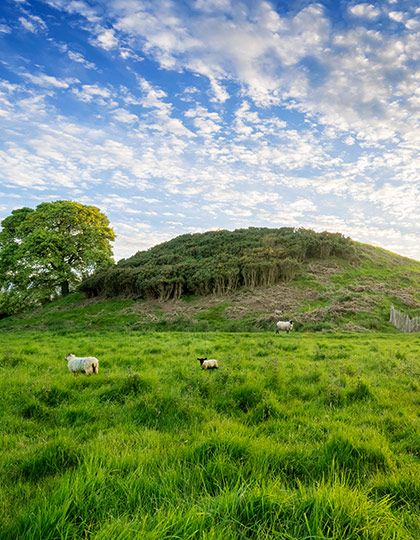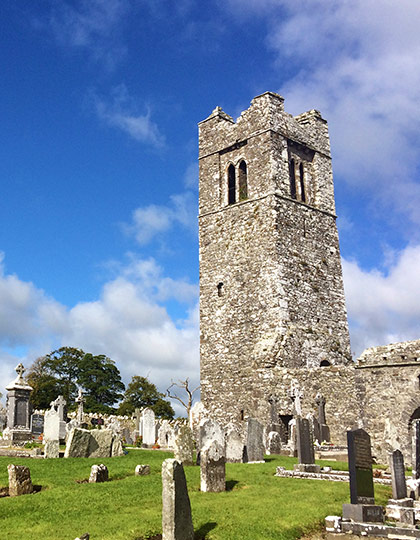 Book a tour
Book a tour
Fourknocks, while smaller in size compared to Newgrange, offers a more intimate and personal experience as a passage tomb for visitors.
There is no Visitor Center, and oftentimes, there is nobody else around. This ancient marvel offers a serene environment to be appreciated and enjoyed.
We can explore the chamber at our own pace, immersing ourselves in the mesmerizing megalithic art . One notable engraving within the chamber possibly depicts a human face, if so it would be Ireland’s oldest anthropomorphic representations.
Constructed approximately 5000 years ago, Fourknocks stands contemporaneous with Newgrange and other passage tombs in the Boyne Valley, situated 16km (10 miles) southeast of Newgrange. The name “Fourknocks” originates from the Irish “Fuair Cnoic,” meaning Cold Hills.
The site features a short passage leading into a spacious pear-shaped chamber with three smaller offset chambers. Originally, a wooden structure likely supported the roof, but in 1952, a concrete roof was added following a two-year excavation. Among the discoveries were fragments from 65 burials, encompassing both cremated and unburnt remains of adults and children. Additionally, decorated pottery, vessels, and personal ornaments such as pendants and beads were unearthed, all of which now reside in the National Museum.
While the entrance lacks a solar alignment, the Fourknocks mound aligns with the Winter Solstice sunrise path toward Newgrange. In the Stone Age, the passage at Fourknocks aligned with the helical rising of the W shaped constellation Cassiopeia, potentially explaining the prevalence of zigzag megalithic art with a W shaped motif at Fourknocks.
In this section

Fourknocks Passage Tomb
This ancient passage tomb, dating back 5,000 years, is situated on a hill overlooking the village of Naul, to the southeast of Newgrange.
The primary passage tomb, known as Fourknocks One, is under the guardianship of the State, open to visitors, and provides a fascinating glimpse into Ireland’s ancient past. The interconnected tombs within the complex, described by Gabriel Clooney, showcase a gradual ‘twinning’ process between Fourknocks One and Two over thousands of years, resulting in complementary ritual settings. Notably, while the passageway in Fourknocks One ascends, its counterpart in Fourknocks Two, just 50 meters to the east, descends.
The passageway of Fourknocks One opens to the northeast. The chambered cairn can be easily entered if you go with a guide, or you can arrange to get the key by following the instructions signposted at the entrance to the path to Fourknocks. Inside the chamber, initially shrouded in darkness, the megalithic art becomes visible as your eyes adjust. Light vents in the roof facilitate visibility, and additional illumination from a smartphone or torch enhances the experience.
Excavated in the early 1950s, Fourknocks One underwent reconstruction with a concrete domed roof, and the exterior was re-grassed to resemble its pre-excavation appearance. Climbing to the top of the mound rewards visitors with panoramic views from the Wicklow mountains to Slieve Gullion in County Armagh. Situated 16 km (10 miles) southeast of Newgrange in the Boyne Valley and 17.7 km (11 miles) east of the Hill of Tara, Fourknocks One stands as a captivating testament to Ireland’s rich archaeological heritage.
The passage, measuring 5 m (17 ft) in length, guides visitors into a spacious circular chamber, measuring 5.5 m (18 ft) by 6.4 m (21 ft). Exhibiting a distinctive bloated cruciform shape, the chamber features three recesses adorned with geometric patterns known as megalithic art, with zigzags being particularly prominent. Notably, attention is drawn to the zigzags above the lintels, sparking speculation about their potential role in identifying different tribes or families, or perhaps serving as star maps. One of the standing stones is said to depict a face.
Bone fragments from approximately 65 individuals were found in the passage and the three side recesses, dating both from Neolithic times and later re-use during the Bronze Age. Cremated remains and unburned skulls and long bones were discovered, carefully positioned, sometimes with associated small stones. Grave goods including stone and bone pendants and beads, chalk marbles, pins (including a stunning antler pin), flints, and stone balls were also found.
The chamber’s roof, partially corbelled, likely closed off with a wooden roof supported by timber. Alternatively, some propose the intriguing possibility that it remained open, serving as a star observatory. Martin Brennan suggests that the zigzags on certain stones may represent Cassiopeia, the W-shaped constellation visible from Fourknocks during the Neolithic era. This raises questions about the chamber’s function, as it is puzzling how an open-sky chamber aligns with the conventional notion of a burial mound. Clearly, much remains to be uncovered and understood about this captivating site.
Show MoreThis location features in the following tours
When you book with Boyne Valley Tours you will experience over 5,000 years of Irish Culture and History. Choose from our tours across the Boyne Valley as well as popular Wicklow Tours and Highlights.





